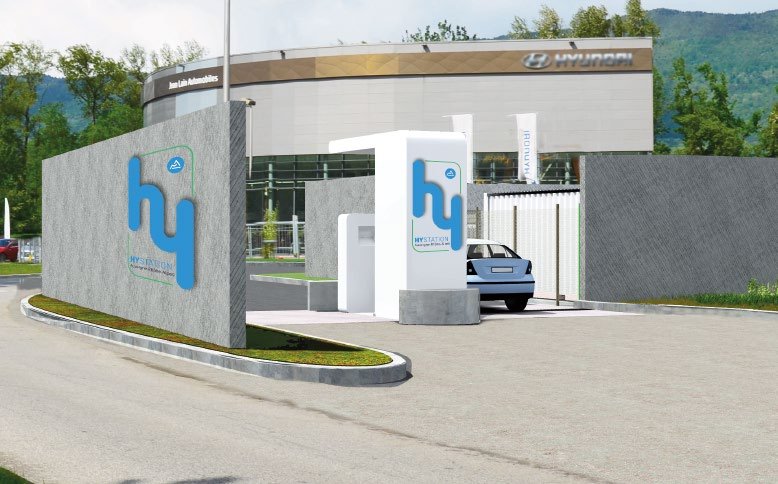France Hydrogène and the Automotive Platform (PFA) with IRT SystemX have carried out a modeling of the needs in hydrogen charging infrastructure for land mobility in metropolitan France by 2030 with a transition point at 2026.
LThe study presents different master plans to optimize the number, location and sizing of H2 stations for recharging light and heavy vehicles.
The role of hydrogen in road mobility is recognized asme essential in the decarbonization of transport, in particular for light vehicles and LCVs which are particularly well suited to intensive use, but also to meet the operational and environmental constraints to which heavy goods vehicles are subject. Hydrogen passenger vehicles and light commercial vehicles are already available on the market and heavy goods vehicles, in the demonstration phase, will enter the pre-commercialization phase by 2026.
To reverse the “chicken and egg” situation that hydrogen mobility regularly faces, it is necessary to support its deployment by proposing a coherent geographical network of charging stations, taking into account regulatory constraints at European and French levels.
For vehicles, the modeling is based on data from fleets in circulation from the Ministry of Ecological Transition and studies by the PFA (1). Demand is concentrated on professional uses, with a high proportion of LCVs in the light vehicle segment, these vehicles being marketed and particularly suited to these uses. In terms of time horizon, the modeling includes a transition point at 2026, a relevant near deadline for LVs and LCVs. For heavy goods vehicles, the time horizon considered is 2030, corresponding to a trajectory for placing vehicles on the market.
For the location of the stations, the modelling mainly targets the EPCI located in the 43 ZFE-m in 2026. Indeed, since the regulations apply to some of these priority zones from now on (and until 2025), an immediate solution must be available for them.
For heavy goods vehicles, the grid takes into account a French fleet but also foreign heavy goods vehicles using the trans-European transport network (TEN-T). The modelling is in line with the obligations of the European regulation on alternative fuels infrastructures (AFIR) implying a minimum distance between 2 stations.
What scenarios?
The modelling shows in the short term a fleet of 50,000 light vehicles that are supplied from more than 210 stations when the fleet reaches more than 340,000 vehicles at nearly 750 stations in 2030. These vehicle fleets are made up of more than 80% light commercial vehicles and are mainly concentrated on priority EPCI. As for heavy goods vehicles, the fleet circulating in France reaches more than 11,000 vehicles in 2030 that are supplied from nearly 170 stations.
By 2030, the cumulative charging infrastructure for light vehicles and heavy goods vehicles will therefore approach 1,000 hydrogen stations across the country, in line with the objectives of the reference scenarios of the National Hydrogen Strategy and those of the prospective studies “Trajectory for a great hydrogen ambition”, carried out by France Hydrogène.
From reality to projects
The first phase of the modelling made it possible to identify master plans for the deployment of hydrogen charging infrastructure based on a match between supply and demand at the national level. These models must now be compared with a more detailed vision of the projects already underway or to come in the territories as well as regional specificities and trajectories.
This will involve, for example, aligning the model with existing or planned stations, questioning the targeted EPCI, exchanging with regions that are implementing master plans or aligning the networks of stations for light vehicles and those for heavy goods vehicles.
(1) Modeling of hydrogen charging infrastructure needs for land mobility in France, PFA, February 2023.
Maps: © PFA, France Hydrogène
« The challenge to develop hydrogen mobility is to match the development of the vehicle supply with the deployment of a coherent charging infrastructure. The first phase of this work carried out within the framework of the National Hydrogen Council makes it possible to propose a geographical network of charging stations and a dimensioning correlated to demand. Hydrogen mobility needs visibility for the most accurate planning of the deployment of the infrastructure and thus accelerate the decarbonization of heavy and/or intensive road transport. This is the contribution that we wanted to make with this infrastructure modeling study which must continue in the coming months.
“The European Commission’s ambition to reduce CO emissions2and the Ban on thermal engines in 2035 for light vehicles require a very significant acceleration of electrification, mainly battery electric vehicles, but also hydrogen vehicles, two complementary technologies. Hydrogen fuel cell vehicles meet the intensive uses of the LCV, taxi, bus, heavy-duty and long-distance truck segments, by guaranteeing zero-emission mobility, a fast filling time, the expected autonomy and high towing and payload capacities. A simultaneous deployment of the well-positioned infrastructure, with more than 1,000 stations for France, is necessary to support the vehicles already offered by manufacturers, nearly 350,000 of which will be on the road in 2030.
“IRT SystemX has developed tools to model the evolution of hydrogen demand to explore different infrastructure deployment scenarios. For SystemX, the objective is to support the H2 sector in its development by providing visibility on the deployment of infrastructures according to dynamics and contexts, and indicators to support local and national strategies.”

